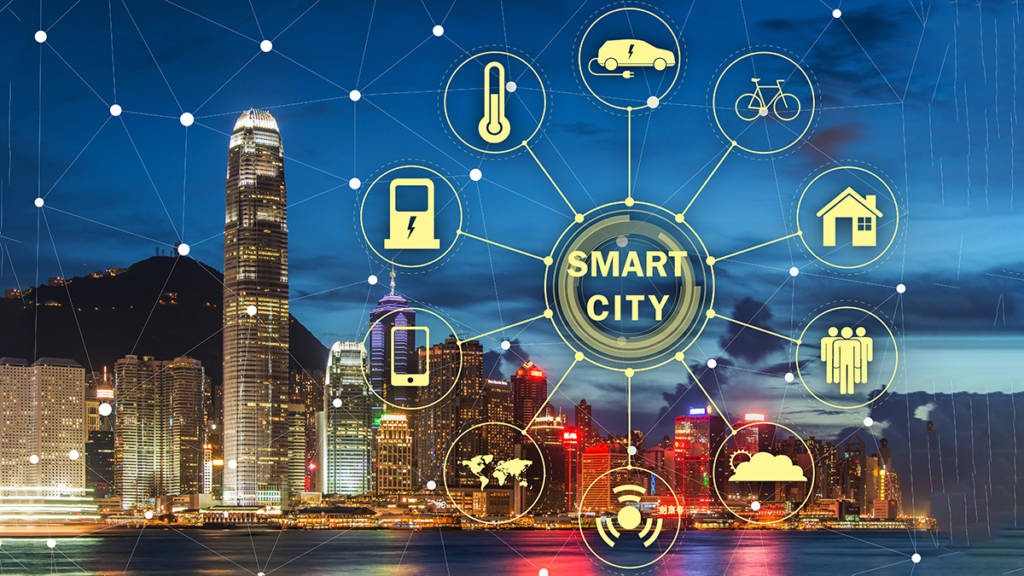As the IoT space continues to grow and evolve, it shows up across many sectors and categories, from building automation, industrial and agricultural, to smart city, medical and military. Most people are familiar with the virtual assistant and home automation IoT ecosystems based around Amazon Alexa, Google Home devices and Samsung Smartthings. Still, the potential of larger-scale industrial IoT systems is not to be underestimated.
By 2025, smart city infrastructure is predicted to provide more than 40% of all smart city income worldwide, according to Statista, with MarketsandMarkets predicting global IoT in the smart cities market will grow to over £250 billion by 2026. A smart city can take many forms; it can integrate parking and autonomous vehicles or connect street lighting, renewable energy sources, traffic and bridge monitors in an urban area.
Depending on the particular system, a smart city can include many devices and connection methods, each with its own set of challenges for integration and operation. Security remains one concern and proves a top priority, with the attack surface increasing as more devices connect to network infrastructures. So how is IoT currently showing up in smart cities, and what are the opportunities and potential pitfalls as it continues to evolve?
The smart grid
The smart city is an example of an IoT ecosystem that contains many devices currently used daily, including lighting controls for streetlights, municipal transportation, autonomous vehicles, energy monitoring and many others.
One system included in this network is the smart grid, which uses IoT devices to monitor the power grid to help with tasks such as fault monitoring, predicting usage, automating demand response and reducing greenhouse gas emissions from power production plants. The smart grid also improves the security, efficiency, reliability and resiliency of the grid itself.
Smart meters can monitor usage at customer sites, providing grid operators with data on usage and demand and allowing operators to notify customers about issues and outages. Monitoring generating equipment, substations, transformers or power lines can help warn operators about grid attacks and potentially help isolate problems to smaller locations. Linking microgrids and renewable energy sources can boost efficiency. Some work is already under way to allow interoperable communications and controls between plug-in EV and EV support equipment.
Right now, some of the more significant issues with smart grids lie in their interoperability, with some saying that the lack of communications standards and common protocols is hampering interconnectivity efforts. It’s imperative to prioritise interoperability between tech and IoT devices and verify that any new technology implemented works well and fits seamlessly with the city’s existing infrastructure and tech. This issue will need to be resolved as smart grids become more prevalent and integral to power delivery.
Smart parking
A lack of available parking spaces is one of the major reasons for traffic jams in urban locations. Congestion and parking are interrelated because searching for a free parking spot creates additional delays and increases local circulation.
With smart parking, sensors embedded in parking spaces can detect whether a spot is occupied or available. This IoT data is transmitted wirelessly to the cloud, where it is collected and analysed in real time to produce a map of open spaces. Drivers can use applications on their smartphones – or potentially in infotainment systems integrated into vehicles – to locate available spaces, some with the ability to reserve and pay for parking, helping to keep traffic moving and things flowing seamlessly throughout the city.
Bridge monitoring
Monitoring the structural integrity of bridges is an essential task for today’s infrastructure. Naturally, all structures have a design lifespan. It is crucial to maintain bridges and roadways and be aware of their ultimate lifespan, as failure can result in significant social and economic impacts. Many areas require certain inspection intervals for bridges and infrastructure, traditionally a manual activity, often leading to data inconsistency and a limited number of data collected.
In recent years, destructive and non-destructive testing techniques are used for structure and bridge repair and maintenance. The applications of non-destructive testing techniques such as 3D laser scanners, ultrasound, vibration and deformation-detecting sensors, as well as ground-penetrating radar technologies, have developed in this field.
Although it would be imprudent to say that sensors will solve all bridge inspection issues, IoT sensors can supplement scheduled manual inspections. By providing real-time data, IoT sensors can help monitor infrastructure for defects and alert maintenance personnel to potential issues as they occur, potentially saving lives and building consumer confidence.
As with all new technological advances, there are barriers to adoption that need careful consideration. If global markets are to be fully ready and able to adopt smart city life, including the technical skills gap and local authority funding, it’s clear that there are tangible benefits to smart city adoption.
There are also security concerns about the use of smart city technologies, particularly those that collect personal data about local behaviour, public services or critical infrastructure. Some projects have been called out for prioritising the implementation of new technologies over citizens’ needs, and allocating these new technologies to benefit the affluent city dwellers, meaning rural and urban communities are missing out. To build consumer trust, governments and local authorities must ensure they comply with local laws and regulations regarding data privacy, testing and certification of new technologies. They need to remain transparent and honest throughout the process.
Nevertheless, the continued progress is exciting, and it’s fascinating to imagine what could be next for major cities as smart technologies are implemented throughout the country and the world.
Maan Ghanma is Director of Smart Solutions at UL Solutions. Maan has been with UL Solutions for over four years, focused on local and global market access of smart and IoT devices, and the growth of these smart and wireless markets. Prior to joining UL Solutions, Maan was at CETECOM Inc for over eighteen years, holding the role of CEO in his last five years at the company.
